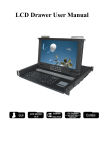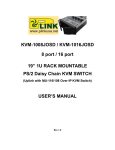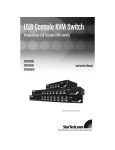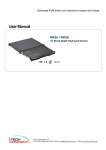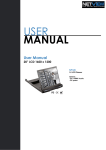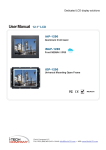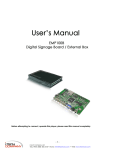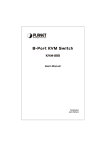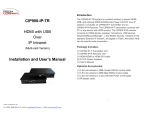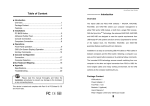Download User Manual
Transcript
HK119e LCD Drawer User Manual O cRfbcQ^ o ocP°oo LCD Monitor 15"/17"/19" l-TECH COMPANY i-Tech Company LLC TOLL FREE: (888) 483-2418 • EMAIL: [email protected] • WFR: w.AAW.iTechLCD.com ■ 1- Table of contents 1. BRIEF INTRODUCTION ………………………………………………………..... 3 2. PACKAGE INSIDE …………………………………………….…..……………… 3 3. FEATURES ………………………………………………….……………………… 3 4. SPECIFICATIONS …………………………………………………………………. 4 5. INSTALLATION ……………………………………………………………………. 5 6. USAGE ( Hotkey Commands and OSD Operations ) …………………………….. 9 -2- BRIEF INTRODUCTION The 1+1 Console 8/16 port LCD KVM switch can control attaching servers and computers from local or remote console. This LCD KVM switch is loaded with features such as one local console port, plus one optional CAT. 5 based remote console port or one optional IP based remote console Port, On Screen Display (OSD) Menu, Password security, Hot key Control, Push Button and Auto Scan Control. It has complete keyboard and mouse emulation for simultaneous PCs boot-up process. With the CAT.5 based remote console port you can remotely control servers and computers 1000 feet away. In other words, you can locate your monitor, keyboard and mouse up to 1000 feet away from the LCD KVM switch. The built in CAT.5 transmitter synthesizes VGA monitor and keyboard/mouse signals, and transmit the signals to the remote CAT.5 receiver over the popular LAN (CAT.5) cable. With the IP based remote console port you can control one or many computers locally at the server site or remotely via the Internet using a standard browser. You can securely gain BIOS level access to systems for maintenance, support or failure recovery over the Internet. Communication is secure via SSL encryption. PACKAGE INSIDE 1x LCD Drawer Unit 1x User Manual 1x Rack Mount Kit 1x Power Cord FEATURES Support combo(PS/2 & USB) interface for connecting to computer ports conveniently One optional remote console (Insertion Card : CAT.5 or IP Module) Support MS windows, Netware, Unix, and Linux Support iMAC, Power MAC and Sun Micro Systems with USB connection. No Software Required --- easy computer selection via On Screen Display (OSD) Menu, Push Buttons, and Hotkeys Provide various Hotkey (Scroll-Lock/ Cap-Lock/ Num-Lock/ L-Alt/ L-Ctrl/ L-Win/ R-Alt/ R-Ctrl/ R-Win) for switching computer port and other control functions, so Hotkey function can be used in various types of keyboards, and to avoid Hotkey duplicate problem. Provide ACL (Access Control List) security function. Store up to 8 independent user accounts Hot Plug --- add or remove connected computers without powering off the LCD Drawer Support two user layers, and search computer/server name Keyboard status restored when switching computer Support Daisy chain(8-layer) & Cascade(2-layer) function -3- SPECIFICATIONS Feature Specification PC Type Combo (PS/2 & USB Connector Support) PC Port Connector HDB 15 PC Ports 1 / 8 / 16 Max. Distance (LCD Drawer to PC) 16 feet (5m) LCD Resolution 15” LCD : 1024 * 768 Video Resolution (Remote Console) 1600 x 1200 for CAT.5-Based 500 feet remote console 1024 x 768 for CAT.5-Based 1000 feet remote console 1600 x 1200 for IP-Based remote console CAT.5 - Based (Optional) Remote Console Module 17” & 19” LCD : 1280 * 1024 RJ-45 Connector, CAT.5 console up to 1000 feet away from Drawer with superior, auto-adjust RGB gain/delay control capability RJ - 45 8P8C for 10/100 M Ethernet, Over IP -Based (Optional) DB9 male for Modem, Null modem and serial power control, Remote Module Mini USB 2.0 receptacle Daisy Chaining Support Daisy chain(8 - layer) & Cascade(2 - layer) function Computer port selection On Screen Display (OSD) Menu, Hot Key, Push Button Hotkey Provide various Hotkey (Scroll-Lock/ Cap-Lock/ Num-Lock/ Alt/ Ctrl/ Win) LEDs Power on & Selection Security Provide ACL (Access Control List) security function, store up to 8 independent controllable Computers lists Multilingual OSD (On Screen Display) control 8 Languages (English, France, German, Spanish, Italian, Russian, Japanese, Simplified Chinese) Auto-Scan Intervals 5 ~ 99 Sec. Keyboard Emulation PS/2 or USB Mouse Emulation PS/2 or USB Max. PC Connection >1024 Housing Metal Operation Temperature 0 ~ 50℃ Storage Temperature -20 ~ 60℃ Humidity 0~95%, Non-Condensing Mechanical 19” Rack mount, 1U Dimension (mm) 580 * 450 * 42.5 -4- 8 port LCD Drawer Front VIEW 8 port LCD Drawer Rear VIEW If you want to add a remote console module, please break this plate with a flathead screw driver. Diagram ( 16 port LCD Drawer ) INSTALLATION On the back of the KVM Switch, each of the 8 / 16 PC ports has a HDB15 type connector. Each cable that comes with the Switch has a 3-in-1 connector at one end and a single HDB15 male connector at the other end. Plug the single connector end of the cable into the KVM PC port, and then plug the other end of cable to a PC VGA port. -5- Figure 1. 3-in-1 DB15 cable (a) PS/2 computer --- Plug in the PS/2 mouse connector to the computer mouse port, then the PS/2 keyboard connector to computer keyboard port. Figure 2. 3-in-1 DB15 Cable and PS/2 to USB Adaptor (b) . USB computer --- Install a PS/2-to-USB adapter to the keyboard PS/2 connector, plug in USB connector to the PC USB port. This single USB port can handle both keyboard and mouse data. Optional Modules Installation Over IP Module Please refer to “Over IP Module User Manual” for details. Installation: Power off the LCD Drawer firstly. Remove the cover of the add-on slot, slide in the Over IP Module and make sure the module is fully inserted into the slot. The Over IP Module redirects local keyboard, mouse and video data to a remote administration console. It allows you to control one or many computers locally at the server site or remotely via the Internet using a standard browser. Serial Power Control The IP Module comes with a serial port for connecting to any serial device, such as serial PDU to provide remote power control, such as power on, power off, and power cycle for the connected computers/servers. -6- Figure 3. IP-Module Diagram CAT. 5 Transmitter Module Installation : Power off the LCD Drawer firstly. Remove the cover of the add-on slot, slide in the CAT. 5 transmitter module and make sure the module is fully inserted into the slot. To extending your console up to 1000 feet away by connecting the CAT. 5 cable to the R-Box in the remote end. CAT. 5 Module Receiver (R-Box) The CAT.5 module receiver (R-Box) uses CAT.5 cable to extend your keyboard, mouse and monitor 1000 feet (300 meters) away from the KVM switch. It also has built in 2 port KVM switch for selecting remote or local Computer. Figure 4. CAT. 5 Module Diagram -7- CAT.5 Receiver Installation Make sure the CAT.5 cable is straight through type. Plug one end of CAT.5 cable into RJ-45 connector of the KVM switch CAT.5 console port, and plug the other end of CAT.5 cable into RJ-45 port of the R-Box. Connect keyboard, mouse and monitor to the R-Box console port. Connect Local Computer to R-box with the accompanied 3-in-1 HDB15 cable. Power on the R-Box by plugging in the power adapter. Push the SELECT button to select remote or local Computer. Daisy Chain Connection Use one end of daisy chain cable to connect to the Daisy Chain port of Master KVM switch and connect the other end of daisy chain cable to the Local Console port of the next Slave KVM switch. Please repeat the connection procedures for next Slave KVM switch. You can daisy chain up to eight banks in maximum. Figure 5. Daisy Chain Connection The console OSD menu will show only the port information of the master KVM switch. When the master unit starts up, it will query all daisy chained Slave units, and automatically set up the Bank ID for each Slave unit. So the 7-seg LED on the Master unit will display 1, Slave 1 will display 2, Slave 2 will display 3, and so on. If not so, please reset (press “BANK” and port button) the Master unit to update the Bank ID immediately. Hot Plug function is supported in daisy chain connection. The Master unit will auto-query the daisy chained Slaves every 30 seconds. You can also cascade through computer port. This cascade can work with other brand of KVM switch, but you need to change the Hotkey of slave KVM switches so that the master and slave KVM switches do not use the same Hotkey. -8- Figure 6. Cascade through Computer Port Usage ( Hotkey Commands and OSD Operations ) Buttons The push Buttons 1 ~ 16 : You can simply switch to a port by pressing the corresponding button. For 16 ports LCD Drawer, please press button 1 ~ 16 directly to select the port you want. Hotkey You can conveniently command LCD Drawer through a simple hot key sequence. To send commands to Drawer, you must press the hotkey (default Caps Lock) twice within 2 seconds. You will hear a beep sound confirming entering Hotkey mode. If you do not press any key during Hotkey mode over 2 seconds the Hotkey mode will be escaped and back to Normal state. The default hotkey is Caps Lock but you can change hotkey as your application convenience. If you prefer to use other hotkey, please go to OSD menu and change the default hotkey to the other. The table blow lists all supported hotkey commands. The default hotkey starts from “Caps Lock”+“Caps Lock”, then the keys on the table list. -9- Command Function Space bar Brings up the OSD overlay screen ↑ Switches to the previous port ↓ Switches to following port ■ The first digit is the Switch bank number, starting with “1”. The KVM switch on the daisy chain line is [01, 02,..,32] port on bank 1 (the Master). A standalone KVM switch is also on bank 1. ■ The second & third digits are port numbers starting [1,2,..,8] bank, with “01” Pg. Up Switches to the previous bank Pg. Dn Switches to next bank B Turns the beep sound on/off R For SUPERVISORS that will set the OSD back to the factory default value (except the User Security settings). S For SUPERVISORS that activates the Auto-Scan function U For SUPERVISORS that turns the Security function on/off. (Default is off). P Log out, that’s only valid when the security is on. Example #1 – To bring up the OSD overlay window, press Caps Lock”, “Caps Lock”, and the “Space Bar”. Immediately, the OSD overlay screen will appear. The superimposed menu screen is generated by the LCD Drawer, and does not affect your computers or software function in any way. Caps Lock Caps Lock please enter next key in 2 seconds in the Hotkey sequence Space Bar Example #2 – To switch to Bank 1 Port1, press “Caps Lock”, “Caps Lock”, and “1”, “0”, “1”. Caps a Lock Caps Lock 1 0 1 please enter next key in 2 seconds in the Hotkey sequence Actually there are two methods to bring up the OSD overlay window. 1. Activate OSD by press Hotkey --- press Hotkey twice then press Space bar. 2. Activate OSD by Mouse --Press and hold the left button of the mouse and hit the Esc key to show the Status screen. Press and hold the right button of the mouse and hit the Esc key to bring up the Main Menu. - 10 - OSD (On Screen Display) OSD Menu provides a menu-driven interface to control the LCD KVM switch. This OSD Menu has four types of display screens: 1. 2. 3. 4. Login Window --- When powering on this LCD KVM switch, it will prompt a login window and ask for user name and password. This OSD function can setup one SUPERVISOR and eight USERs. SUPERVISOR can access to all OSD functions. USER can access to port name and port search only. Status screen --- after the log in the Status screen will show up to display the current port settings and Hotkey type. Port Name --- this menu displays port status, and you can switch to other port right here. Main Menu --- there are eight menus to operate. They are listed as below: MAIN MENU Function 01 LANGUAGE OSD language selection 02 PORT NAME EDIT PORT NAME modification 03 PORT SEARCH Quick searching by port name 04 USER SECURITY Change password 05 ACCESS LIST Define user access authority 06 HOTKEY Change Hotkey 07 TIME SETTINGS Modify auto-SCAN time interval 08 OSD MOUSE Modify OSD MOUSE speed Login Window Power on the local console monitor, and power on the KVM Switch by plug in the power adapter. If the Security function is enabled (default is disabled), the Login window will show up waiting for user name and password. The Login window The default is SUPERVISOR and default user name is eight zeros “00000000”. The default password is eight zeros “00000000”. There are case-insensitive, while OSD display fixed in upper case. After login or port switch by panel button, OSD or Hotkey, the Status screen will show up to display the information of current settings -- one digit BANK NUMBER, two-digit PORT NUMBER, PORT NAME, and current Hotkey settings. Pressing any key or moving mouse will let the Status screen disappeared. The selected bank no. The selected port no. The port name The Status screen The selected Hotkey - 11 - Auto-LOGOUT function In Login window, if no input for username and password over 1 minute, the screen will disappear. Hit any key to bring up the Login window again. At normal operation, if no input from the console keyboard or mouse over 10 minutes the LCD KVM switch will turn off the screen display and show up Login window asking for user name and password. One more minute of keyboard/mouse inactivity, the monitor will be turned off The first page shows the current port name and the selected port, and the operation hint. The selected bank The selected port Operation Hint User Level Auto-Scan Interval OSD Function Key Firmware Version Description F1 Go to the Main Menu F2 To log out the OSD. If Security is enabled it will show up the Login window waiting for username and password. If Security is disabled it will show up the Status window F3 Previous Menu Enter ↑ / ↓ Switch to the selected port Select the port (press Enter to switch) PgUp Previous Bank PgDn Next Bank Esc Exit 1 Show ports 01 ~ 08 2 Show ports 09 ~ 16 3 Show ports 17 ~ 24 4 Show ports 25 ~ 32 - 12 - ■ USER --- There are two types of user levels: SUPERVISOR and USER. The default is SUPERVISOR. SUPERVISOR can setup and change the OSD settings at Main Menu. USER can only do the port switch and port search. ■ SCAN TIME --- This is the time interval for auto-scan function. When auto-scan function is activated, the KVM switch will auto-scan the host port one by one in the interval as setting. Notice that the port without connecting to a computer/server will be skipped over on the scan. ■ The numeric keypad is not supported, while in OSD screen, the arrow keys, PgUp, PgDn, and Enter keys are supported. Main Menu There are eight menus to choose from. LANGUAGE The OSD supports eight languages: English, French, German, Italian, Spanish, Simplified Chinese, Japanese, and Russian. The default language is ENGLISH. Moving the cursor by keyboard (Up Arrow key “”or the Down Arrow key “”) or mouse to select the language you like. - 13 - PORT NAME EDIT The first line bar is Bank number, following lines are port name list. Use keyboard (Up Arrow key “”, Down Arrow key “”) or mouse to select the port. After select the port, you can either press the Enter Key, or move the cursor to port name and double click left button of mouse to switch the port immediately. Press PgUp key or PgDn key for selecting the previous or next Bank. Press Enter key for editing port name. Press Esc key to cancel the editing without any change or press Enter key to complete the editing. PORT SEARCH Search the computer by port name. Enter “*” will show the all the port names. USER SECURITY There are two types of user levels: SUPERVISOR and USER. There is one SUPERVISOR and up to eight USERs can be configured. Press the Enter key or right button of mouse for editing. The left-top “S” means SUPERVISOR, and “1”, “2”, “3”,…., “8” mean USERs. The maximum length of NAME and PASSWORD is eight characters (A~Z and 0~9). - 14 - ACCESS LIST Only SUPERVISOR can configure the ACCESS LIST. The first column is the port number, following the server/computer name list. The last 8 columns are the access right of each user. Use the Enter key or left button of mouse to active/deactivate the access right of each port. “X” means to disable access and “O” means to enable access. HOTKEY Some keyboards may not equip with all the special keys. Making sure the key you select is available in you keyboard. TIME SETTINGS When the Auto-Scan function is activated, the LCD KVM switch will auto-scan the host ports one by one in the interval as setting. Notice that the port without connecting to a computer/server will be skipped over on the scan. The interval range is 5 ~ 99 seconds, and the default interval is 10 seconds. Press “Enter” key to save the SCAN TIME setting. - 15 - OSD MOUSE You can change the moving speed of mouse cursor in this item. There are three levels to choose from. The fastest moving speed is "FAST", the second is "MIDDLE" and the slowest is "SLOW". Using " ♦ " and " ♦ " key on keyboard to move highlight bar to the wished speed. Press the Enter key to go into effect. Certifications FCC This equipment has been tested and found to comply with Part 15 of the FCC Rules. Operation is subject to the following two conditions: (1) This device may not cause harmful interference (2) This device must accept any interference received. Include interference that may cause undesired operation. CE This equipment is in compliance with the requirements of the following regulations: EN 55 022: CLASS B. RoHS All contents of this package, including products, packing materials and documentation comply with RoHS. C€ F£ Trademarks: All the companies, brand names, and product names referred to this manual are the trademarks or registered trademarks belonging to their respective companies. I-TECH COMPANY i-Tech Company LLC TOLL FREE: (888) 483-2418 • EMAIL: [email protected] • WEB: www.iTechLCD.com - 16-

















